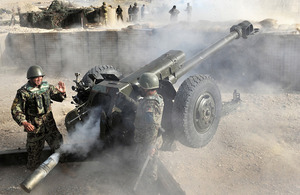Afghan and Brit Gunners conduct first live firing exercise
Afghan National Army Gunners have marked the end of five months of training alongside British troops with the first multinational partnered live firing exercise to take place in Helmand.

An Afghan National Army gun crew fire their Russian-made D-30 artillery gun [Picture: Sergeant Rupert Frere RLC, Crown Copyright/MOD 2011]
Members of Colchester-based 7th Parachute Regiment Royal Horse Artillery (7 Para RHA), who form part of the ISAF Brigade Advisory Group in Helmand, have been mentoring the Afghan Gunners since arriving in the Gereshk area last year.
As they reached the culmination of five months’ training this week, the Afghans’ new skills were put into practice with a ‘live firing confirmatory exercise’, of the type commonly carried out by trainee Gunners in the UK.
The 7 Para RHA mentors, who have been living, working and training alongside their Afghan colleagues, were able to watch as their hard work paid off and the Afghan Gunners fired high explosive ammunition for the first time.
The exercise was made possible by co-operation between Afghan, UK, Danish and American forces. Manning their Russian-made D-30 guns, the Afghans fired alongside British Gunners equipped with the 105mm light gun and Danish troops with their 120mm mortars. Thirty rounds of each nature were fired onto a single target area, while observers from America, Afghanistan and the UK looked on out of sight, miles away.
The first multinational live firing exercise of its kind in Helmand, it saw troops from Afghanistan, Britain and Denmark fire their respective weapons individually before coming together at the end to fire in unison.
For the Afghan Gunners of the 4th Kandak, 3rd Brigade, 215 Corps of the Afghan National Army, who have been stationed on an austere hill overlooking the town of Gereshk in southern Helmand, this was a chance to prove that their British training has brought them up to the standard of serving as professional specialists in the Afghan National Army.
The hill, which offers excellent views over the Helmand River and the Green Zone, is known to the Afghans as ‘Tapa Topche’, and to the Brits as ‘Artillery Hill’. It is a partnered position where a British light gun battery and an Afghan D-30 battery live side by side, both providing offensive fire support to Afghan, British and Danish troops on the ground.
For the British mentors of F Troop, 7 Para RHA, the chance to work alongside the Afghans and assist them in the development of a domestic artillery capability has provided a unique operational tour experience. Learning to live with the cultural differences, overcome a significant language barrier and teach on a piece of equipment that is not overly familiar to them are just some of the challenges that the British mentors have had to deal with.
Special training was laid on in Finland last summer so that the British Gunners could learn how to operate the Russian-made D-30 122mm howitzer guns. Language training was also undertaken by all of the mentoring gun ‘number ones’, although interpreters still play a vital role during the daily lessons on gun drills.
Major Mike Lynskey, Royal Artillery, Officer Commanding Close Support Kandak Team in the Brigade Advisory Group, said:
This has been a fantastic training day which represents the culmination of five months’ hard work for the British mentors, but more so the Afghan Gunners. This represents the first step towards a truly independent Afghan National Army artillery capability. The next step involves a good deal more hard work, but with more live firing days like today the goal is certainly achievable.
Sergeant Paul Challoner, a mentoring gun number one, said:
You could see the improvements in the Afghan Gunners after just one day’s live firing. The increased level in confidence they had after handling live ammunition and firing live for the first time is credit to all the hard work they have put in over the past five months.
Sergeant Ishmael, a firing sergeant in the 4th Kandak, said:
This has been a great day because we have been working hard alongside our British friends and colleagues from 7 Para RHA and today we were able to put that into practice. I look forward to the day when we as Afghans can do this all on our own.